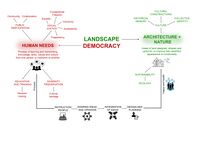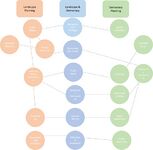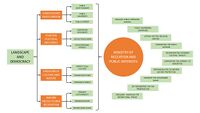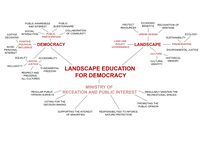Democratic Landscape Transformation 2024 - Team 18
>>> Back to working group overview
>>> Back to seminar reading list
>>> go to the Editing Help
Background of your team
Please present your team briefly. Which linguistic and cultural perspectives does each member bring in? Which disciplinary backgrounds are present in your team?
- Marika Donadelli (Italia, UNIBO - Engineering and Architecture at the University of Bologna)
- Fataneh Fatahi ( HSWT)
- Lashika Sabesan (Sri Lanka - BSc (Hons) Town and Country Planning, Germany - International Master of Landscape Architecture (M.Eng.) (reading))
- Muhammad Hamza (Pakistan- B.Arch Architecture and planning, Germany - International Master of Landscape Architecture (M.Eng.)
Your Landscape Democracy Manifestoes
Here you can add links to the manifestoes you have presented on April 24. Please make sure that the links are accessible. You can also add them directly here on the wiki, they need to be png or jpg format then.
- https://drive.google.com/file/d/1xoEYjLqtXoa0z6G_k9ObUA3ECKrSxJmS/view?usp=sharing
- https://drive.google.com/file/d/1Vn6cyWyd7apeAVM1OY1QQ2pOpGsuEOMX/view?usp=sharing
- https://drive.google.com/file/d/1TyM55A5-9G2vgtZpB9ls4rV-FoSeQaW7/view?usp=drive_link
- https://drive.google.com/file/d/1xi3y-mz_qP1g6o6vK2ZmoglFIBSksMtm/view?usp=drive_link
Readings, concepts and definitions
- Start: April 3, 2024
- Due: July 2, 2024
While working in your group, please start to express your personal understanding of the relation of landscape and democracy in the form of a concept map with linking words or any other diagrammatic representation. Please make your maps very visual and not just verbal. Think critically about why one map differs from another.
The final product is a shared concept map that integrates the various understandings present within your team.
About concept mapping
Before starting the exercise you can read this article by Joseph D. Novak & Alberto J. Cañas about Theory Underlying Concept Maps and How to Construct and Use Them. This paper gives a good explanation of how concept maps are conceived and developed.
You can use any tool you like for producing your concept map. However, since the result needs to be submitted digitally we recommend the following open source software for producing your maps:
- Cmap Tools >>> you can also work with your group on the Cmap cloud doing a shared map
- VUE - The Visual Understanding Environment
- Use a shared whiteboard to develop your integrated concept map, such as MIRO or MURAL
How to present your concept maps
- Possible format: JPG (for wiki upload) or link to any other resource
- We give you below a draft image gallery where you can add pictures of your map (in JPG or PNG format)
- You can present your integrated understanding as one concept map or your present individual ones and the integrated one.
- add as many additional materials as you need
Overview of your concept maps (individual and integrated)
Please finish with a short reflection
- What are the similarities and differences in your team regarding your understanding of what democratic landscape transformation is?
- In how far did the seminar lectures and readings help you to clarify this?
- What will you take home from this seminar?
Democratic Landscape Transformation group 18 – Reflection
Landscape planning and democracy are crucial aspects for landscape planners. Initially, our understanding of these concepts was limited, but the seminar provided us with extensive knowledge and insights. Through group discussions, we explored various perspectives on the social implications of landscape planning and the use of different approaches and electronic tools in facilitating landscape democracy. Group Discussions and Collaborative Learning
Our seminar was characterized by rich, collaborative discussions where members shared their ideas and experiences. This platform allowed us to explore different aspects of social meaning and to learn about various approaches to landscape planning and democracy. We also gained knowledge about the electronic tools that can aid in this process.
Diverse Perspectives
The diversity within our group significantly enriched our discussions. We had members from different countries, languages, and socio-political backgrounds, which provided a wide range of perspectives on landscape democracy.
• Marika Donadelli (Italy): Marika shared her insights on bridging human needs with the architectural environment. She explained various approaches to connecting these aspects and emphasized the importance of integrating human�centric design with ecological considerations.
• Lashika Sabesan (Sri Lanka): Lashika highlighted the differentiation between landscape and democracy planning. She integrated both concepts through key principles of landscape democracy, emphasizing the importance of planning and democracy integration.
• Muhammad Hamza (Pakistan): Muhammad provided an overview of how to integrate landscape democracy in the region. He discussed different approaches to achieving landscape democracy, focusing on the importance of different approaches to ensure and maintain the landscape democracy.
Conceptual Mapping
Our group developed an integration concept map that illustrated the differentiation between landscape and democracy concepts. This map offered various ideas on how to achieve landscape democracy through different approaches. Despite our different methods of explanation, we found common ground in emphasizing social, environmental, and cultural values.
Common Values and Different Methods
Although we approached the topic from different angles, our core ideas were similar. We all considered the importance of social value, environmental value, and cultural value in landscape planning. The diversity of our methods enriched our understanding and provided us with a comprehensive view of how to implement these values in landscape planning and democracy.
Gained knowledge from seminar
The seminar on landscape planning and democracy significantly enhanced our understanding and provided us with valuable insights into integrating these concepts. Through collaborative discussions, diverse perspectives, and conceptual mapping, we have gained a deeper appreciation of the importance of participatory planning and the use of electronic tools in landscape democracy. This experience has prepared us to implement these principles in our future projects, ensuring that landscape planning is inclusive, sustainable, and democratic.



